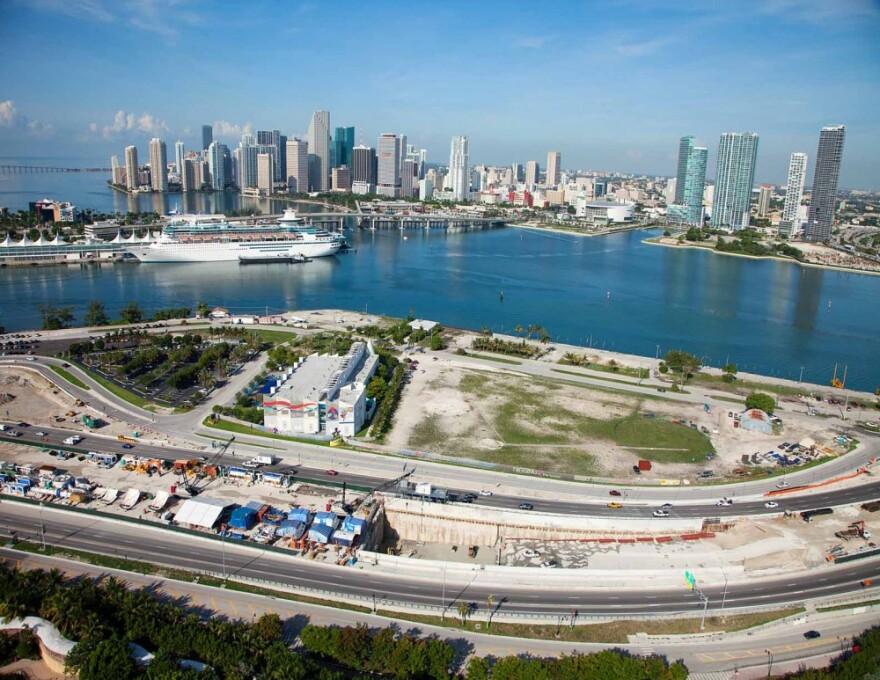The PortMiami Tunnel--a $1 billion hole in the ground that began with a task force more than 30 years ago--finally celebrates its completion Monday.
Traffic will now be able to access the port from I-395 by taking a the tunnel entrance on Watson Island, driving below Government Cut and resurfacing on Dodge Island, where PortMiami is located.
According to project numbers, an average of 16,000 vehicles per day have been driving through downtown Miami en route to PortMiami. A good chunk of that traffic was made up of tractor trailers heading off I-95. Which, according to Miami Access Tunnel vice president Chris Hodgkins, was a harrowing endeavor.
“You’re coming down south. You’re going to get in that far left-hand lane, where it says Miami Beach, MacArthur Causeway, 395,” explains Hodgkins. “And then they would veer into the right-hand lane. And then they would have to go down Biscayne.”
Trucks had to take that same 395 to Biscayne Blvd. exit that tends to back up during Miami Heat games.
“They would go through five traffic lights,” says Hodgkins, “spewing all their diesel each time they stopped, queuing up at that ramp that would back traffic up on the 395 and then onto 95.”
A Florida Department of Transportation official says that particular situation -- traffic backing up from the Biscayne Blvd. exit onto 395 and then onto I-95 -- does happen, but only occasionally.
With the PortMiami Tunnel, trucks won’t have to take that exit ramp at all and will cross fewer lanes of traffic getting tunnel access.
But the number of trucks actually making that drive represent just fraction of the big-rig wheels on I-95. Depending on the particular stretch of road, almost 16,000 trucks per day travel along I-95 in South Florida according to FDOT numbers.
From the warehouse to I-95
Some of those trucks start their journey from a small warehouse in Doral.
“It’s a little cold in there,” says Enrique Lima, transportation operations manager at Armellini Express Lines, as he opens his warehouse door and is greeted by a blast of 37-degree air. He walks inside towards one of thousands of rectangular cardboard boxes and looks at a label.
“This is where it’s coming from: Ecuador, South America. These are roses,” Lima says. “This one is going to Romulus, Mich.”
The Armellini company is a mover of flowers. Other companies import the flowers from Latin America and sell them all over the country. Armellini gets them there, more often than not, on I-95.
“It is the main artery out of South Florida and into South Florida,” says Lima. “Any company that’s down here or ends up down here does have to use I-95.”
Out in the Armellini driver’s lounge, a few guys sit while Family Feud plays on a TV next to a vending machine.

Driver Pablo Diaz is still waiting to hear where he’s headed today. Diaz has done the overnight 95 shift a number of times and says the first leg can be the worst leg.
“The problems on I-95 are when you drive during rush hour,” says Diaz. “Some drivers are going very fast to go home, they’re in a hurry to go home so they cut you off on the road.”
The cost of trucking
Aside from the emotional toll, traffic has an actual cost. The Texas A&M Transportation Institute estimates that in 2011 South Florida congestion cost the trucking industry almost $750 million.
Between Port Everglades and PortMiami, moving goods has become a crucial part of the local economy.
“We’re not just sun and tourists,” says Richard Biter, FDOT’s Assistant Secretary for Intermodal Systems Development.
He says, while expensive, transportation projects like the PortMiami Tunnel are ways of getting goods moving and making the region a more viable place to run a business. With the expansion of the Panama Canal, even more freight could be heading out of local ports and up I-95 -- which would give further weight to Biter’s proposed motto for I-95.
“As I like to say, it goes from Florida to Maine. As opposed to the other way around.”





